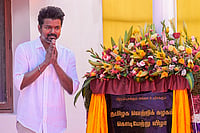Judy Brown, a wrinkled schoolteacher from New Zealand, was aghast. Aboard Star Cruise ship SuperStar Virgo on the Malacca straits this July, she would encounter Indians everywhere—the nightclub, karaoke bar, top deck, restaurants or elevators. Not one to mince words, Judy wondered whether the "pushing", "screaming" bunch of Indians was part of a grand design by some evil force to ruin her holiday.
It wasn't. The unusually large number of Indians on the ship was courtesy of Mahamaza, a company selling all sorts of consumer goods online, deciding to reward its best performing webstore owners. About 100 of them, appointed pointsmen who take orders from buyers and source the goods online using an assigned ID, had been chosen to take the cruise from among 3,00,000 spread largely over the Hindi heartland.
Now, Mahamaza is no Google. Its webstore owners are a far cry from engineering-dropouts-turned-garage-entrepreneurs. They are mostly small-town folk—petty businessmen, lowly government servants, housewives, etc—whose tech savvy would perhaps begin and end with logging on and placing orders. Still, they are people whose lives have been transformed by their association with Mahamaza, whose annual turnover has raced from zero to Rs 90 crore a year in three years.
This is not the dotcom euphoria of the mid- and late '90s. This is the dotcom reality of the 2000s. As realities go, it's not over-the-top. It has none of the irrational exuberance of the boom days when there'd be at least half-a-dozen venture capitalists vying for the latest bright idea of the latest engineering dropout, mundane things like revenue streams and path to profitability be damned. Yet, unlike most realities, this is a happy one.
The Internet economy is on the rebound. All its key aspects—usage, page views, online advertising and e-commerce—have been growing at a heartening pace for a year and projected to grow much faster in the years ahead. Bottomlines have been improving, and valuation too. "These are the first signs of dawn. And it is not like 1999-2000, when the boom was mainly investment-led," says Ajit Balakrishnan, CEO, Rediff.
After a prolonged stupor, the number of Internet users in the country (conventional wisdom puts five users to each connection) has jumped to 22 million from about 17 million at the end of the last financial year, is projected to touch 24 million by March 2005, and on to 57 million by March 2007.
The Internet user base got a much-needed fillip when it became somewhat less dependent on personal computers in households and offices, thanks largely to proliferating Internet cafes and mobile phones. At last count, there were about 30 lakh people reaching the Internet through cellphones, a rise of about 175 per cent over last year. Figures for Internet cafes, not an organised industry, are difficult to get, but among the few organised efforts, Sify's network of 2,000 cafes—under the iWay brand name—caters to no less than 5 lakh people every month. Internet telephony, which has dramatically reduced the charges on long distance—including overseas—calls, and video conferencing are also drawing in the crowds. "It is not unusual to see parents coming to cafes with babies whose images can be beamed to the grandparents in some other country," says Sify CEO R. Ramraj.
As the number of people in cyberspace has increased, advertisers have followed. Online advertising is expected to touch Rs 100 crore this year, compared with Rs 40-odd crore last year. This would still be less than 1 per cent of the total advertising pie. However, this share is projected to grow to 2.5 per cent (Rs 280 crore out of Rs 11,250 crore) in 30 months. This is in consonance with the surge in global online ad spend to $9.1 billion, up from $7.3 billion last year and exactly $1 billion more than the figure in the boom year of 2000. "Now, we don't have to work as hard as we had to earlier to get advertising," says Balakrishnan.
"The factors in favour of the medium are its inherent interactive nature and the possibility of creating multiple communications to appeal to different segments. Its low cost is also a major plus since experimentation becomes a very low-risk proposition," says a Maruti spokesperson. Adds Ish Bawa, marketing manager, BenQ India: "One just can create more impact as online is a more engaging medium, and best suited to response-led campaigns."
The Net's interactive nature is manifest in another area. Surfers are ever willing to transact online. They're buying mobile ringtones, air and rail tickets, CDs and DVDs, apparel and accessories, and big-ticket items like home appliances and electronic gadgets. "The Net has become a virtual marketplace, with direct interaction between providers and consumers of goods and services," says Mahendra Swaroop, head of Indiatimes. This has done away with the component of profits at the intermediary levels from the eventual cost to the consumer. Thus, Calvin Klein half-sleeve shirts were going on Rediff recently for Rs 450, a 70 per cent discount to the market price. Similar discounts are available on almost everything on various websites.
B2C e-commerce has already jumped to Rs 430 crore, from Rs 255 crore last year, and, on current trend, is projected to touch a whopping Rs 4,000 crore in 2007. This has led to the emergence of a new business model for portals, reducing their dependence on traffic and advertising.
Strangely enough, the organisation that must be credited with the biggest fillip to e-commerce, business to consumer, is the much-maligned Indian Railways. The largest employer in the world has emerged the largest online revenue generator in the country's B2C space with its online ticketing facility, clocking Rs 8-10 crore worth of booking every month. Far bigger than the figure is the change in attitude that this service is ushering in. Word has it that a fairly large percentage of housewives, including grandmothers, prefer buying tickets online to standing or making someone in the family stand in a queue.
Some 80,000 came to Sify's iWay cafes in the last 12 months to take banking tests. A software developed by Sify enables it to take questions from a set prepared by the bank giving the test and throw them at random to the candidates. At a time, different candidates get different questions so that they can't cheat. It has brought down the cost of conducting these exams and done away with the need for candidates to travel to examination centres. The results of a typical two-hour test are out in minutes, handed over to the candidate even as he prepares to leave the cafe.
The proof of the pudding is in company top- and bottomlines. Sify has reported a 29 per cent rise in sales to $16.91 million for the quarter ended June 30, 2004, over the same quarter of last year, and a cash profit of $1.65 million against a cash loss of $1.39 million. Rediff has reported a third successive happy quarter. Its revenues from operations for April-June 2004 have increased 24 per cent to $2.6 million from $2.1 million in the same quarter last year. Significantly, India Online, consisting of online advertising and fee-based services, contributed $1.1 million, an increase of 51 per cent compared to the same quarter last year. Net loss for the quarter, even though it included loss from discontinued operations of $1,50,000 due to the sale of the ValuCom phone card business in early April 2004, fell to $0.51 million from $2.02 million.
The good news is not confined to general portals.It is a happy story in the niches too. Indiabulls' recent initial public offering was oversubscribed 18. 5 times. Founded by Sameer Gehlaut, CEO and single largest shareholder, along with two of his IIT-Delhi batchmates, the securities trading outfit saw net profits rise by over 100 per cent to Rs 8.8 crore and sales by 67 per cent to Rs 27.9 crore in the quarter ended September 2004, compared to the same period the previous year. Normally, existing investors exit through dotcom ipos, but, points out Gagan Banga, head (sales & marketing), Indiabulls: "None of our investors has exited." Why would they? In November 2000, when Rishi Sahai of VC firm Infinity Technology Investments wrote a cheque for Rs 7.7 crore to pick up an 11.5 per cent stake in Indiabulls at Rs 8 a share, his friends and colleagues asked him to treat the amount as a sureshot write-off. Today, Sahai is being credited with remarkable foresight as the investment has shown a nearly 350 per cent profit at the current scrip price of Rs 35. "Those who persisted with technology firms are now getting lucrative exit options through ipos," says Sahai.
Business is also booming at matrimonial sites like Shaadi.com. Owned by Anupam Mittal's People Group, it has more than 2 million registered users and claims 1,00,000 successful matches.
Deals like Rajesh Jain selling his Indiaworld.com to Satyam for Rs 499 crore in November 1999 will perhaps never find an encore. But the valuation in recent deals would warm the hearts of funds-hungry dotcommers. A few months ago, online recruitment firm Monster paid $9 million for Indian jobs portal jobsahead.com, while the world's biggest online retailer eBay paid $50 million for Indian auction and shopping site baazee.com. "Although it is early days for e-commerce in India, we believe there is great opportunity over the long term," Meg Whitman, president and CEO of eBay, had said while announcing the deal.
Now that the buzz is back in technology firms, VCs are again queuing up. Of the total VC funds expected to flow into India this year—about $1.1 billion—a tenth will be in Internet-specific firms. That's an encouraging growth over last year's figure of $773 million (less than $25 million in Internet-specific investments) and only $590 million ($60.5 million) in 2002. However, unlike the boom days, the money is being invested in late-stage ventures and the amounts too are bigger. The average size of a VC deal has increased to about $10 million, up from $1-3 million in 1999-2000. "It is serious money now, not nascent tech funds. And it is focusing on mature deals," explains Sahai.
The next few months will be exciting, as broadband is slated to take off in a big way. A boost in this direction came this week in the form of a communications ministry announcement of a new broadband policy which aims to increase broadband users to 20 million by 2010. By ensuring high-speed connectivity (at least 256 kbps) that will be on all the time and cost a fixed sum every month irrespective of the usage, it's expected to provide the next inflection point in the life of the Internet. Apart from boosting usage, it will also enable a whole lot of applications that need faster connectivity. "The always-on aspect makes the average consumer run to a PC whenever he wants something. So the usage goes up," says Balakrishnan. Thorny issues like last mile connection and dependence of private Internet service providers on state-owned telephone service operators may also be solved by the new policy. That's why, as he drives from Colaba to his office in Worli every morning, the large numbers of hoardings en route offering broadband at low prices make Balakrishnan's mornings a lot more pleasant.
Webgyor
The Internet is booming again. In usage, advertising, e-commerce and VC funds.

Webgyor
Webgyor
Published At:
MOST POPULAR
WATCH
MORE FROM THE AUTHOR
PHOTOS
×





















